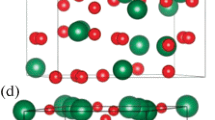Abstract
Scandium trifluoride (ScF3) exists in a cubic ReO3 structure that exhibits negative thermal expansion from 10 to 1100 K, while substituted Sc1−x Y x F3 materials display the same behavior at room temperature but transition into positive thermal expansion rhombohedral phases upon cooling. We have measured the heat capacity of ScF3 from 0.4 to 390 K and found no evidence of a phase transition, but do find that its low-temperature heat capacity is anomalously high. The heat capacities of substituted Sc1−x Y x F3 materials are also reported and show evidence of the cubic-rhombohedral phase transition for x ≥ 0.1 and smaller anomalies in the low-temperature heat capacity of the positive thermal expansion rhombohedral phases. To aid in interpretation of these results, the heat capacity of ScF3 was calculated from its phononic structure using density functional theory.




Similar content being viewed by others
References
Romao CP, Miller KJ, Whitman CA, White MA, Marinkovic BA (2013) Negative thermal expansion (thermomiotic) materials. In: Reedijk J, Poppelmeier K (eds) Comprehensive inorganic chemistry, vol 4. Elsevier, Oxford, pp 128–151
Greve BK, Martin KL, Lee PL, Chupas PJ, Chapman KW, Wilkinson AP (2010) Pronounced negative thermal expansion from a simple structure: cubic ScF3. J Am Chem Soc 132:15496–15498
Li CW, Tang X, Muñoz JA, Keith JB, Tracy SJ, Abernathy DL, Fultz B (2011) Structural relationship between negative thermal expansion and quartic anharmonicity of cubic ScF3. Phys Rev Lett 107:195504-1–195504-5
Morelock CR, Greve BK, Gallington LC, Chapman KW, Wilkinson AP (2013) Negative thermal expansion and compressibility of Sc1−x Y x F3 (x ≤ 0.25). J Appl Phys 114:213501-1–213501-8
Allen PB, Chen YR, Chaudhuri S, Grey CP (2006) Octahedral tilt instability of ReO3-type crystals. Phys Rev B 73:172102-1–172102-4
Morelock CR, Gallington LC, Wilkinson AP (2014) Evolution of negative thermal expansion and phase transitions in Sc1−x Ti x F3. Chem Mater 26:1936–1940
White MA (2012) Physical properties of materials. CRC Press, Boca Raton
Romao CP, Miller KJ, Johnson MB, Zwanziger JW, Marinkovic BA, White MA (2014) Thermal, vibrational, and thermoelastic properties of Y2Mo3O12 and their relations to negative thermal expansion. Phys Rev B 90:024305-1–024305-9
Larson AC, Von Dreele RB (2000) General structure analysis system (GSAS). Los Alamos National Laboratory Report, LAUR, pp 86–748
Toby BH (2001) EXPGUI, a graphical user interface for GSAS. J Appl Cryst 34:210–213
Kennedy CA, Stancescu M, Marriott RA, White MA (2007) Recommendations for accurate heat capacity measurements using a quantum design physical property measurement system. Cryogenics 47:107
Johnson MB, White MA (2014) Thermal methods. In: Bruce DW, O’Hare D, Walton RI (eds) Inorganic materials: multi length-scale characterization chap 2. Wiley, New York, pp 63–120
Gonze X, Amadon B, Anglade P-M et al (2009) ABINIT : first-principles approach to material and nanosystem properties. Comput Phys Commun 180:2582–2615
Gonze X, Beuken J-M, Caracas R et al (2002) First-principles computation of material properties: the ABINIT software project. Comp Mater Sci 25:478–492
http://www.sasupenn.edu/rappegroup/htdocs/Research/psp_gga.html
Perdew JP, Burke K, Ernzerhof M (1996) Generalized gradient approximation made simple. Phys Rev Lett 77:3865–3868
Drymiotis FR, Ledbetter H, Betts JB, Kimura T, Lashley JC, Migliori A, Ramirez AP, Kowach GR (2004) Monocrystal elastic constants of the negative-thermal-expansion compound zirconium tungstate (ZrW2O8). Phys Rev Lett 93:025502–1–025502-4
Gallington LC, Chapman KW, Morelock CR, Chupas PJ, Wilkinson AP (2014) Dramatic softening of the negative thermal expansion material HfW2O8 upon heating through its WO4 orientational order-disorder phase transition. J Appl Phys 115:053512-1–053512-5
Monkhorst HJ, Pack JD (1976) Special points for Brillouin-zone integrations. Phys Rev B 13:5188–5192
Ledbetter HM (1973) Estimation of Debye temperatures by averaging elastic coefficients. J Appl Phys 44:1451–1454
Mittal R, Chaplot SL, Kolesnikov AI, Loong C-K, Mary TA (2003) Inelastic neutron scattering and lattice dynamical calculation of negative thermal expansion in HfW2O8. Phys Rev B 68:054302-1–054302-7
Zwanziger JW (2007) Phonon dispersion and Grüneisen parameters of zinc dicyanide and cadmium dicyanide from first principles: origin of negative thermal expansion. Phys Rev B 76:052102-1–052102-4
Kennedy CA, White MA (2005) Unusual thermal conductivity of the negative thermal expansion material, ZrW2O8. Solid State Commun 134:271–276
Miller KJ, Johnson MB, White MB, Marinkovic BA (2012) Low-temperature investigations of the open-framework material HfMgMo3O12. Solid State Commun 152:1748–1752
Jakubinek MB, Whitman CA, White MA (2010) Negative thermal expansion materials: thermal properties and implications for composite materials. J Therm Anal Calorim 99:165–172
Yamamura Y, Ikeuchi S, Saito K (2009) Characteristic phonon spectrum of negative thermal expansion materials with framework structure through calorimetric study of Sc2M3O12 (M = W and Mo). Chem Mater 21:3008–3016
Zunger A, Wei S-H, Ferreira LG, Bernard JE (1990) Special quasirandom structures. Phys Rev Lett 65:353–356
Fultz B (2010) Vibrational thermodynamics of materials. Prog Mater Sci 55:247–352
Acknowledgements
This study was supported by the Natural Sciences and Engineering Research Council of Canada, the Sumner Foundation, and the Canada Foundation for Innovation, the Atlantic Innovation Fund and other partners that fund the Facilities for Materials Characterization managed by the Institute for Research in Materials at Dalhousie University.
Author information
Authors and Affiliations
Corresponding author
Electronic supplementary material
Below is the link to the electronic supplementary material.
Rights and permissions
About this article
Cite this article
Romao, C.P., Morelock, C.R., Johnson, M.B. et al. The heat capacities of thermomiotic ScF3 and ScF3–YF3 solid solutions. J Mater Sci 50, 3409–3415 (2015). https://doi.org/10.1007/s10853-015-8899-y
Received:
Accepted:
Published:
Issue Date:
DOI: https://doi.org/10.1007/s10853-015-8899-y




